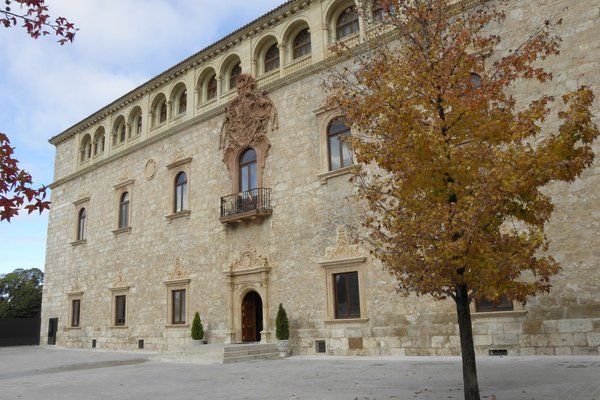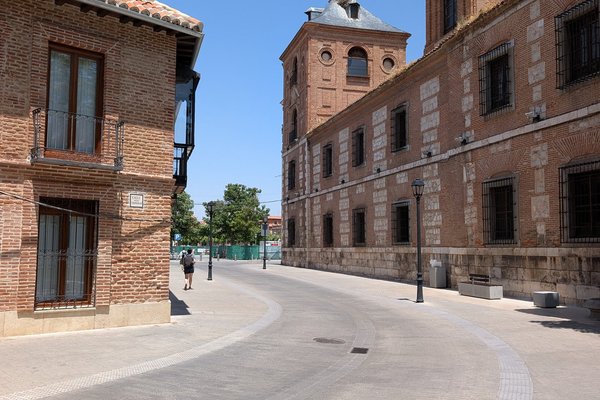Spain
Alcala de Henares
The University and Historic Precinct of Alcalá de Henares was the first city in the world to be designed as the seat of a university, by the concept of an Ideal City.
The primary objective of this University (from 1499) was to train administrators for the Church and for the Spanish Empire. It was at this university that the Spanish language was given its definitive grammatical structure. Alcalá is also the place of birth of the writer Miguel de Cervantes (Don Quixote).
Community Perspective: The city was much more important in the past than it is now, so a visit can be underwhelming. Recommended sights are the Archbishop’s Palace, the birthhouse of Miguel de Cervantes, and the Laredo Palace.
Site Info
Official Information
- Full Name
- University and Historic Precinct of Alcalá de Henares (ID: 876)
- Country
- Spain
- Status
-
Inscribed 1998
Site history
History of Alcala de Henares
- 1998: Inscribed
- Inscribed
- Type
- Cultural
- Criteria
- ii
- iv
- vi
Links
- UNESCO
- whc.unesco.org
- Official
-
- turismoalcala.es — Turismo Alcala
All Links
UNESCO.org
- whc.unesco.org — whc.unesco.org/
Official Website
- turismoalcala.es — Turismo Alcala
Community Information
- Community Category
- Secular structure: Science and Education
Travel Information
Madrid hotspot
Recent Connections
-
Perfect Inscriptions
1998 -
Poetic Quotations
Derek Wallcott about Alcalá de Henares:… -
Obelisk
One at Plaza de las Bernardas & one at …
Connections of Alcala de Henares
- Individual People
-
-
Christopher Columbus
Was received here in 1486 by Isabella the Catholic to discuss the funding of his travels (nomination file)
-
- Architecture
-
-
Gothic
Cathedral -
Plateresque
The facade of the Colegio Mayor de San Ildefonso -
Renaissance
University -
Mudejar style
Chapel and Auditorium of Alcala de Henares university
-
- World Heritage Process
-
-
Perfect Inscriptions
1998
-
- Religion and Belief
-
-
Jesuit Order
Jesuit College and Church -
Cathedrals
Magesterial Cath
-
- Constructions
-
-
Hospitals
Hospital de Antezana (1483) -
Theatres and Opera Houses
Corral de Comedias -
Obelisk
One at Plaza de las Bernardas & one at Plaza Palacio, in front of the Archiepiscopal PalaceSee www.mundandy.com
-
- WHS on Other Lists
-
-
Europa Nostra Award
Façade of San Ildefonso College, Alcalá de Henares (2018 Conservation)
-
- Timeline
-
-
Built in the 16th century
The Universidad y Colegio Mayor de San Ildefonso is the heart of the university city. It was built in 1537-53 (AB ev)
-
- WHS Hotspots
-
-
Madrid hotspot
40min by train
-
- Science and Technology
- Literature & Film
-
-
Poetic Quotations
Derek Wallcott about Alcalá de Henares: "Storks, ravens, cranes, what do these disparate auguries mean? The ski ripened then dulled, then across the chimneys the storks, their legs dangling as if broken, found their nests over the arches of Alcalá, the cobbled city of Cervantes" -
Location for a classic movie
Spartacus (1960, Best Motion Picture – Drama at the Golden Globes)
-
News
No news.
Recent Visitors
Visitors of Alcala de Henares
- 2Flow2
- AC
- Adam Hancock
- Adolfo
- Adrian Turtschi
- Afshin Iranpour
- Alberto Rodriguez Gutierrez
- aleserre
- Alexander Barabanov
- Alexander Lehmann
- Alexander Parsons
- Alikander99
- A. Mehmet Haksever
- Ammon Watkins
- amychemu
- Ana Lozano
- Antonio J.
- Argo
- AS
- Aspasia
- Atila Ege
- AYB
- BaziFettehenne
- Bill Maurmann
- Bin
- Boj
- bossc
- campmany
- Can SARICA
- Carlos Sotelo
- Caspar
- chenboada
- Christian Wagner
- Christine
- Christoph
- Christravelblog
- Claire Bradshaw
- Clyde
- Cody Ayers
- Corinne Vail
- Csaba Nováczky
- ctravel
- CugelVance
- cwthong
- Dagmara
- Daniela Hohmann
- Daniel Chazad
- Dan Pettigrew
- David Aaronson
- David Berlanda
- Dimitar Krastev
- Dimitrios Polychronopoulos
- Dolemite92
- Don Irwin
- Dorejd
- Dwight Zehuan Xiao
- Elaine McArdle
- Elis
- eljx1988
- Els Slots
- Erik Jelinek
- Errol Neo
- Fan Yibo
- Farinelli
- Feldhase
- Femke Roos
- Filip Murlak
- FK
- Frederik Dawson
- GeorgeIng61
- Gernot
- grimloch
- Harald T.
- Harry Mitsidis
- henrik_hannfors
- Hubert
- Iain Jackson
- Ian Cade
- Iara
- Ilya Burlak
- inomusay
- Ivan Rucek
- Jacob Choi
- Jarek Pokrzywnicki
- Jasam
- Jeanne OGrady
- Jezza
- João Aender
- Joel on the Road
- Jonas Hagung
- Jonas Kremer
- Joyce van Soest
- Jurre
- jxrocky
- KarenBMoore
- Karito Vies
- Kasper
- Kbecq
- Ken DJ
- Kevin247
- Klaus Freisinger
- Krzysztof B
- Lara Adler
- Laurine
- Lisu Marian
- Loic Pedras
- Luboang
- Lucio
- Luis Filipe Gaspar
- Maciej Gil
- Maciej Gowin
- Malgorzata Kopczynska
- Manuelfunk
- Martin
- Martina Rúčková
- Marton Kemeny
- Matthewsharris
- MAURO PODDA PANI
- MaYumin
- MH
- M. Huineman
- Michael Novins
- Miguel Marquez
- Mihai Dascalu
- Mikan22
- Mikko
- Milan Jirasek
- Msarmiento1979
- nan
- napalm
- Nick M
- Nihal Ege
- Nikolay Marinov
- Paola Laura
- Patrik
- Paul Schofield
- Peter Lööv
- Petteri
- Philipp Leu
- Philipp Peterer
- Piotr Wasil
- Porcho
- puessergio
- Randi Thomsen
- Riccardo Quaranta
- Rick Ohm
- Roger Ourset
- Roman Bruehwiler
- Roman Raab
- Samy G
- Sandra!
- saraleonela
- Schnitzel
- scubarrie
- SDMArado
- Sergio Arjona
- Shandos Cleaver
- shoaibmnagi
- sibariam
- Simonf
- Solivagant
- Sorel Americo
- Stan
- Stanislaw Warwas
- Stijn
- Svein Elias
- Szabo Viktoria
- Szucs Tamas
- Tamara Ratz
- Taotao Chen
- Tarquinio_Superbo
- Thomas Buechler
- Thomas van der Walt
- Tim Allen
- tony0001
- Traveling Girl
- triath
- Truls Brekke
- Valentina
- Vanessa Buechler
- Viaje al Patrimonio
- voyager
- Walter
- Waters88
- Wojciech Fedoruk
- Xiong Wei
- Xiquinho Silva
- Zhenjun Liu
- Zoë Sheng
- Zos M
- ZZSong
Community Reviews
Show full reviews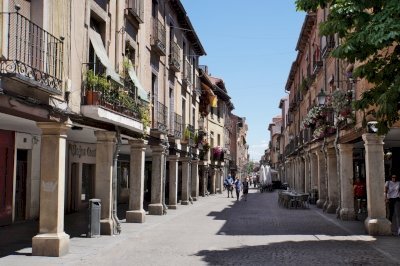
The Old University and Miguel de Cervantes are the keywords that characterize this World Heritage site. Too little to make Alcalá de Henares an overwhelming site, but enough for a pleasant day trip from Madrid or, as I did, one day with an overnight stay.The Universidad Complutense is remarkable because Alcalá de Henares was the first planned university town in the world. The façade of its main building is the showpiece of the town, although the Plateresque decoration is less exuberant than in Salamanca. When you step through the portal, you are standing in the first and most representative of the three courtyards. The rest of the complex can be visited with a guided tour. You can see the other two courtyards, the auditorium and some other rooms. The highlight is the Iglesia San Ildelfonso. It is a mixture of the Renaissance style with a beautiful Mudéjar coffered ceiling. San Ildefonso is also home to the tomb of the university's founder, Cardenal Cisnero.
After the re-foundation of the university in 1977, many of the historic buildings were reused for their original purpose. Nevertheless, Alcala de Henares does not give the impression of a typical university town. Not comparable with Salamanca, for example. And actually, the storks are the real highlight of the city. Certainly, more than a hundred pairs build their nests on the roofs of the houses and churches and contribute significantly to the special charm of this WHS. Most of them can be found on the ruins …
Keep reading 0 comments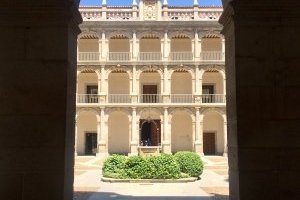
UNique – 2/10
Sometimes, a UNESCO site collector has to make a difficult choice of seeing one site while missing others due to time pressure. Such was the case, as we were waking up in our hotel room in Madrid and brainstorming about which of the three sites to visit on our last day before flying out. We settled on Alcala de Henares, a town outside of Madrid, which prides itself on being the first planned university city in the world. Originally founded in the 16th century, the university’s urban planning aspired to approach the ideal of Civitas Dei (“the city of God”). Within a few centuries, Alcala grew to become one of the most significant universities in Europe.
ESsential – 1/10
The highlight of the city for me was the pedestrian avenue of Calle Mayor, connecting the Cathedral to the University’s Plaza de Cervantes. The street is characterized by the rows of precariously crumbling columns which support the overhanging second floors of the buildings, thus providing a porticoed space for the shops and cafes below. Even if the street has probably seen better days, it still provides a charming walk through town. It is on this street that the birth house of Miguel de Cervantes can be found, right next to the medieval hospital where his father used to work. As for the university itself, while it boasts an impressive facade and an interesting cloister, there are very few buildings that stand out. In fact, the …
Keep reading 0 comments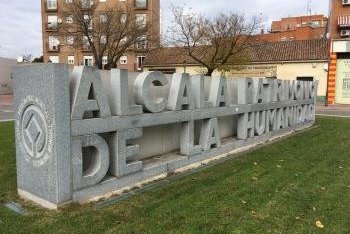
My December 2016 day in Alcalá de Henares was not the most exciting one I've ever had, though I enjoyed spotting the storks that live all over the city's tall buildings.
Although this is still an active university city there wasn’t a lot to do on an overcast weekday in December. I took a look around the archaeological museum and the main university building, but that was pretty much it.
The city does have one of the better UNESCO logos I have seen, carved in along with its name in large stone blocks in the centre of a roundabout just outside the city walls.
Best WHS logos so far: Alcalá, St Lucia (large wooden carving across a valley from Gros Piton) and Cornish Mining Landscape (depicted in flowers in the town of Hayle).
Keep reading 0 comments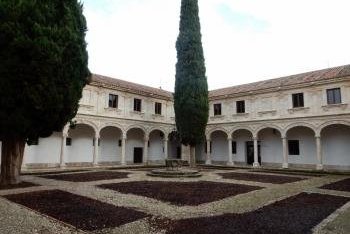
Alcalá is just a short train ride from Madrid and makes a very interesting half-day trip from the capital. Even though I visited on a Monday afternoon, which meant that many sights such as the cathedral and the Cervantes House were closed, I enjoyed my walk through a city oozing with history. Most tourists come to see the Cervantes-related sights, but the town's biggest claim to fame is the university (which offers guided tours also on Mondays). The Universidad Complutense was founded in the 13th century and was one of the most important ones in the Christian world during the Late Middle Ages and Renaissance periods. When it moved to Madrid in the 19th century, the city became a bit of a backwater (a modern university was founded in the 1970s) and a commuter town. The historic university buildings are still well-preserved and make for an interesting visit. Guided tours seem to be offered only in Spanish, so I didn't catch every detail, but it was still a pleasant visit. From the outside, I also saw the neo-Moorish Laredo Palace and the former Palace of the Archbishops of Toledo, where Columbus planned his first voyage and where both Emperor Ferdinand I and Catherine of Aragon, Queen of England, were born.
Keep reading 0 comments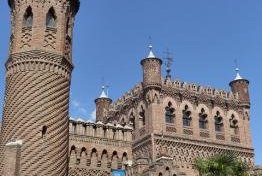
I visited this WHS in June 2015. It was the last WHS I visited from 8 during my Central Spain road trip and I truly wasn't expecting much. However I was pleasantly surprised to find a vibrant multicultural university town with tip-top condition sites, lots to see, interesting hidden jewels and a nesting base for hundreds of storks. Luckily I had decided to stay overnight and therefore I could dedicate almost 2 days to this WHS. These are the WHS I love most, sites that I would have never visited were it not thanks to the list. All the churches, monasteries, university buildings, towers, walls, etc. were completely dominated by storks, so much so that there was a Stork Route to take in all the sites. This added to the enjoyment as there was always something worthwhile to gaze at when stopping at the different squares. The university facade and courtyard are definitely not to be missed as is the Archbishop's Palace. The Cervantes house is free to visit and there is an excellent tapas bar nearby called Lizarron. My hotel was in the Christian Barrio which is perfect to find parking spaces. The main sites are in the Jewish Barrio and the Muslim Quarter. Inside the university there is a list of the Unesco inscribed universities as well as the Unesco plaque. From the bookshop I would recommend everyone who has the time and who decides to stay overnight in this interesting town to book a guided tour of …
Keep reading 0 comments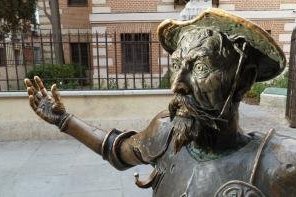
Initially I was rather underwhelmed by Alcala; it just seemed like an unremarkable commuter town. However a slightly rambling wander finally saw me arrive at the grand edifice of the main university building. From then on things started to look up.
Wandering around the main campus I was reminded of my own time studying at an historic European university and I was suitably impressed by the way that the long-standing buildings had been updated for 21st century needs, especially in the chapel that has now become a hi-tech library. The buildings were well presented and buzzing with academic life. Unfortunately the tours didn't match up with my own travel arrangements so I had to make do with just wondering around looking like a lost foreign student.
The main square was pleasant though nothing out of the ordinary; and the same could be said for the cathedral, though the presence of nesting storks on every roof time was thoroughly enjoyable. After this I headed to Cervantes rebuilt birthplace. It was a nice pleasant place to stroll around and get an idea of what a 16th century abode looked like. There was also a good collection of various editions of Don Quixote, making me think I should finally dust off my copy and get past the first 150 pages!
After this I headed back to the station and encountered an unexpected delight in the Laredo Palace a rather wonderful neo-mudjear/ modernisme building that wouldn't look out of place in Eixample in Barcelona.
…
Keep reading 0 comments
Alcalá de Henares wasn’t quite what I had expected. University towns usually have a distinct atmosphere: cozy, lots of young people, interesting museums, small budget restaurants. The thing about Alcalá de Henares is that its university was moved to Madrid in 1836. Only recently, in 1977, a new university has been set up. But a lot of damage had been done in the 1.5 century in between.
After leaving my rental car in an underground car park, I set out for the city center. Information boards in Spanish, English and Braille guide the visitors along to the most important things to see. You’ll definitely need this guidance or bring your own map, as the highlights are somewhat hidden between the dull features of another provincial town. The cityscape isn’t very coherent, because of the many demolitions and modern reconstructions that were executed before they thought of conserving the place. ICOMOS in its AB evaluation states that the city has retained “a substantial degree of authenticity” - which I think is a euphemism.
I first walked to the Archbishop’s Palace. A very fine building with Mudéjar elements. The three trees in front of it in full autumn colours, a couple of passing nuns and dozens of storks nestled on the surrounding roofs gave it a bit extra. In the same area lies the Cathedral. It’s a Magistrial Cathedral, which means that the priests are also professors in University. It is known for its elaborate iron fence (?!). In the …
Keep reading 0 comments
My memory of this picturesque town is of sitting in the Plaza de Cervantes having a picnic lunch watched by a dozen or so storks. These ungainly birds seem to have taken up residence of the roofs of many of the surrounding buildings.
Keep reading 0 comments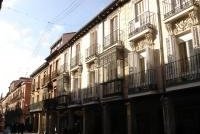
Alcala de Henares, a small town near Madrid, is a home of Spain’s most prestigious university and the birthplace of great Spanish novelist, Miguel de Cervantes, so this city breathes with two things – university and Don Quijote.
As the first planned University town in the world, Alcala de Henares is another example of city planning on the World Heritage List; however, this special characteristic is less obvious as I think this town is just a typical Spanish town in term of urban layout. The prime attraction of the town is university (for sure) which is situated in the town centre area. Strolling around this large and beautifully constructed in Spanish renaissance style university complex is a very nice experience. The must see is the amazingly Paraninfa Hall where the Spanish monarchs give out annual Cervantes Award to outstanding writer.
Alcala de Henares was a prosperous town, in the historic precinct, which is just next to the university, has many nice and attractive balconied buildings and churches. The large city square with a statue of Cervantes is a really surprised as it gave an Italy reminiscent to me. The main reason for most tourists who come to this city is Cervantes Museum which is located on the site believed to be his birth place. The museum is OK with many objects from Cervantes period or the scene from his novels. The most disappointed from this museum is no one can speak English, but it is a free museum so I …
Keep reading 0 comments
Same than Cáceres this WHS is special to me as I live here. Therefore I had to be fond of WHS as I was born in one and live in another one...
Alcalá de Henares is a nice town, with a long history and a fabulous old University building. It's a universitary town therefore you see here a lot of students from many places of Spain and the whole world.
It's only half an hour from Madrid so perfect for a day tour.
Keep reading 0 comments
